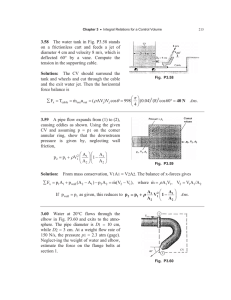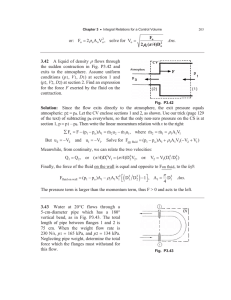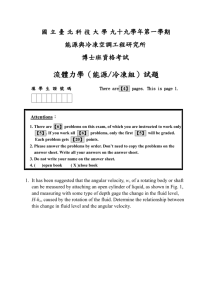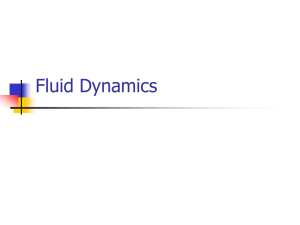Hydraulic and Thermal performance of Microchannel
advertisement
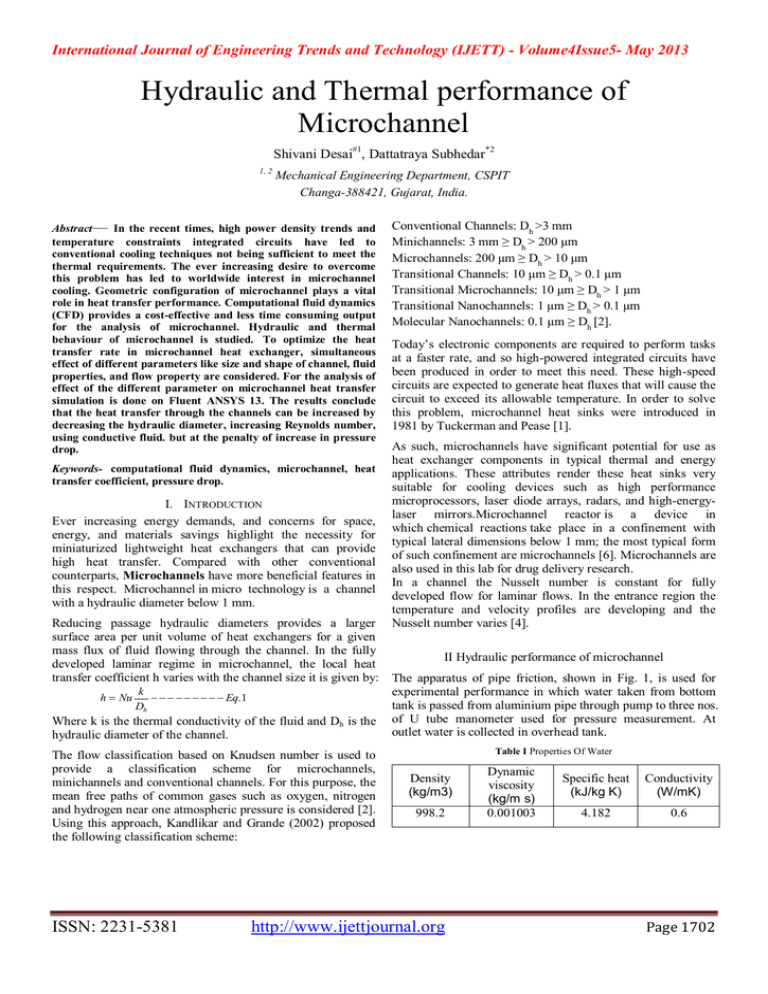
International Journal of Engineering Trends and Technology (IJETT) - Volume4Issue5- May 2013 Hydraulic and Thermal performance of Microchannel Shivani Desai#1, Dattatraya Subhedar*2 1, 2 Mechanical Engineering Department, CSPIT Changa-388421, Gujarat, India. Abstract— In the recent times, high power density trends and temperature constraints integrated circuits have led to conventional cooling techniques not being sufficient to meet the thermal requirements. The ever increasing desire to overcome this problem has led to worldwide interest in microchannel cooling. Geometric configuration of microchannel plays a vital role in heat transfer performance. Computational fluid dynamics (CFD) provides a cost-effective and less time consuming output for the analysis of microchannel. Hydraulic and thermal behaviour of microchannel is studied. To optimize the heat transfer rate in microchannel heat exchanger, simultaneous effect of different parameters like size and shape of channel, fluid properties, and flow property are considered. For the analysis of effect of the different parameter on microchannel heat transfer simulation is done on Fluent ANSYS 13. The results conclude that the heat transfer through the channels can be increased by decreasing the hydraulic diameter, increasing Reynolds number, using conductive fluid. but at the penalty of increase in pressure drop. Keywords- computational fluid dynamics, microchannel, heat transfer coefficient, pressure drop. I. INTRODUCTION Ever increasing energy demands, and concerns for space, energy, and materials savings highlight the necessity for miniaturized lightweight heat exchangers that can provide high heat transfer. Compared with other conventional counterparts, Microchannels have more beneficial features in this respect. Microchannel in micro technology is a channel with a hydraulic diameter below 1 mm. Conventional Channels: Dh >3 mm Minichannels: 3 mm ≥ Dh > 200 μm Microchannels: 200 μm ≥ Dh > 10 μm Transitional Channels: 10 μm ≥ Dh > 0.1 μm Transitional Microchannels: 10 μm ≥ Dh > 1 μm Transitional Nanochannels: 1 μm ≥ Dh > 0.1 μm Molecular Nanochannels: 0.1 μm ≥ Dh [2]. Today’s electronic components are required to perform tasks at a faster rate, and so high-powered integrated circuits have been produced in order to meet this need. These high-speed circuits are expected to generate heat fluxes that will cause the circuit to exceed its allowable temperature. In order to solve this problem, microchannel heat sinks were introduced in 1981 by Tuckerman and Pease [1]. As such, microchannels have significant potential for use as heat exchanger components in typical thermal and energy applications. These attributes render these heat sinks very suitable for cooling devices such as high performance microprocessors, laser diode arrays, radars, and high-energylaser mirrors.Microchannel reactor is a device in which chemical reactions take place in a confinement with typical lateral dimensions below 1 mm; the most typical form of such confinement are microchannels [6]. Microchannels are also used in this lab for drug delivery research. In a channel the Nusselt number is constant for fully developed flow for laminar flows. In the entrance region the temperature and velocity profiles are developing and the Nusselt number varies [4]. Reducing passage hydraulic diameters provides a larger surface area per unit volume of heat exchangers for a given mass flux of fluid flowing through the channel. In the fully II Hydraulic performance of microchannel developed laminar regime in microchannel, the local heat transfer coefficient h varies with the channel size it is given by: The apparatus of pipe friction, shown in Fig. 1, is used for k experimental performance in which water taken from bottom h Nu Eq.1 tank is passed from aluminium pipe through pump to three nos. Dh Where k is the thermal conductivity of the fluid and Dh is the of U tube manometer used for pressure measurement. At outlet water is collected in overhead tank. hydraulic diameter of the channel. The flow classification based on Knudsen number is used to provide a classification scheme for microchannels, minichannels and conventional channels. For this purpose, the mean free paths of common gases such as oxygen, nitrogen and hydrogen near one atmospheric pressure is considered [2]. Using this approach, Kandlikar and Grande (2002) proposed the following classification scheme: ISSN: 2231-5381 Table I Properties Of Water Density (kg/m3) 998.2 http://www.ijettjournal.org Dynamic viscosity (kg/m s) 0.001003 Specific heat (kJ/kg K) Conductivity (W/mK) 4.182 0.6 Page 1702 International Journal of Engineering Trends and Technology (IJETT) - Volume4Issue5- May 2013 This results the total pressure drop of 3413.39pa. By comparing the both values of experiment and simulationpercentage of error found is 1.37%. Entrance effect The Graetz number is defined as in Eq. (2) and is used as a criterion for neglecting the entrance effects. Morini [5] stated that the entrance effects on the average Nusselt number can be neglected if the following inequality is satisfied: Gz < 10 The Graetz number is defined as in Eq. 2 and is used as a criterion for neglecting the entrance effects. Gz For this case, Fig. 1 Experimental setup Where, Pipe ID = 17mm Pipe OD = 21mm Length of section = 1000mm Tank volume = 400 X 400 X 100=1.6e7mm3 Discharge = Tank volume/time for filling tank Density of mercury (Sm) = 13.6gm/mm3 Density of water (Sw) = 1gm/mm3 Re . Pr d h ……………Eq. 2 L Pr = 6.99 Reynolds number (Re) = 63.66 Graetz number ( Gz )= 7.56 Value of Graetz number is less than 10. Thus, the entrance effects on the average Nusselt number can be neglected as show in fig. 2. D (mm) h1 (cm) h2 (cm) Hm (cm) Hf (cm) Time (sec) Reason for taking the entrance effect in account is the channel’s effective length, especially when microchannel is used for small are of heat transfer. If the flow is not fully developed for the entire length for the given flow property , means of Graetz number is more than 10 there is no use of the channel for hear t transfer. At that time we can vary the diameter to get proper heat transfer. 17 27.5 29.90 2.403 30.28 31.3 Effect of diameter on pressure drop Hf = Hm (Sm-Sw) Table II Experimental Results Table IIII Calculations Discharge m3/sec 5.1118e-4 Velocity m/sec 2.2521 Pressure drop pa 3460.968 Effect of varing diameter on hydraudynmic performance of microchannel is shown in fig. 3. The pressure drop increases by reducing diameter for same reynolds number. Simulation Results With same input and same model condition of experimental setup, having same boundary condition simulation is done using ANSYS 13.0 for validation. Here in fig.2 velocity contour is shown for the same simulation of experimental data. Fig. 3 Pressure drop Vs Diameter at Re = 0.2 Poiseuille number for circular pipe is a constant value for laminar flow, Po=f*Re is 16 as shown in fig. 4. There is no change in it by changing the diameter of channel. Fig. 2 velocity counter ISSN: 2231-5381 http://www.ijettjournal.org Page 1703 International Journal of Engineering Trends and Technology (IJETT) - Volume4Issue5- May 2013 Fig. 4 Poiseuille number Vs Diameter at Re = 0.2 Effect of flow property on pressure drop Effect of varing reynolds number on hydraudynmic performance of microchannel is shown in fig. 5. The pressure drop increases by increasing reynolds number for same diameter value. Fig. 6 Experimental setup Where, Pipe ID = 28mm Pipe OD = 32mm Length of section = 400mm Orifice diameter = 14mm Table IIIV Properties of air at 315K Dynamic viscosity (kg/m s) 19.2e-6 Density (kg/m3) 1.1204 Fig. 5 Pressure drop Vs Reynolds number at D = 0.0002mm Specific heat (kJ/kg K) Conductivity (W/mK) 1007 0.027222 Table V shows the experimental values of temperature at different point of the pipe section. Where, T2 to T5 are the temperature of the thermocouple no. 2 to 5 from inlet to inner surface of test pipe. Moreover, T1 andT6 is measured temperature of air stream before and after test section. Table V Experimental result III Thermal performance of microchannel Thermal performance is done with experimental behavior and its simulation which is explained below. Experimental setup The apparatus shown in Fig. 7 consists of blower unit fitted with the test pipe. The test section is surrounded by nichrome bend heater. Four thermocouples are embedded on the test section and two thermocouples are placed in the air-steam at the entrance and exit of the test section to measure the air temperature. Test pipe is connected to the delivery side of the blower along with orifice to measure flow of air through the pipe.it is to be noted that a part of total heat supplied is utilized in heating the air. A temperature indicator with cold junction compensation is provided to measure temperature of pipe wall in the heat section at inlet and exit temperature, of air flow through the section. Table I shows the properties of dry air at 315 k. ISSN: 2231-5381 T1(◦c) T2(◦c) T3(◦c) T4(◦c) T5(◦c) T6(◦c) 42 58 62 63 58 46 Where, T2 to T5 are the temperature of the thermocouple no. 2 to 5 from inlet to inner surface of test pipe. Moreover, T1 andT6 is measured temperature of air stream before and after test section. Heat transfer rate (Qa) = m Cp (T6-T1) = 20W Heat flux (Q) = Qa / A = 568.41 W/m2 Simulation Results With same input and same model condition of experimental setup, having same boundary condition simulation is done using ANSYS 13.0 for validation. Here in fig.8 temperature contour is shown for the same simulation of experimental data. http://www.ijettjournal.org Page 1704 International Journal of Engineering Trends and Technology (IJETT) - Volume4Issue5- May 2013 For this case, Pr = 0.710 Reynolds number (Re) = 1500 Graetz number ( Gz )=0.532726 Value of Graetz number is less than 10. Effect of diameter on heat transfer For fully developed laminar flow the local heat transfer coefficient is improved by changing its cross section shape, its hydraulic diameter, by changing fluid etc. Fig .9 shows the effect of reducing diameter on the heat transfer along entire length of channel. Fig. 7 Temperature contour From the simulation, using ANSYS, the result are as shown in Table VI. Table VI Simulation result T1(◦c) T2(◦c) T3(◦c) T4(◦c) T5(◦c) T6(◦c) 42 56.59 59.13 60.32 61.93 46 CALCULATION Average surface temperature (Ts) = (T2+T3+T4+T5) /4 Average fluid temperature (Tf) = (T1+T6) / 2 Average convective heat transfer (h) = Qa / ( AS (Ts- Tf) ) Fig. 9 Local Heat Transfer Coefficient through length Vs Diameter at, Re = 1500 Where, As is surface area of channel Effect of fluid on heat transfer Results for experimental and simulation are compared as shown in Table VII for the same modelling condition. Conductivity of fluid also a parameter that affect the heat transfer through channel. Here Fig. 10 shows the effects of changing fluid on heat transfer through channel along length. Higher the conductivity of fluid higher the heat transfer is in the result. Table VII Calculation Results Ts (◦c) Tf (◦c) H (w/ m2k) Experimental 60.25 44 34.97 Simulation 59.49 44.013 36.72 Entrance effect Fig. 10 Effect of changing fluid at Dh = 0.0002mm,Re = 1500 Effect of flow property on heat transfer Change in flow property with same hydraulic diameter results as shown in Fig.11. increase in reynolds number increases heat transfer with penalty of increasr in pressure drop. Fig. 8 Entrance temperature contour for D=0.2mm ,Re=1500 ISSN: 2231-5381 http://www.ijettjournal.org Page 1705 International Journal of Engineering Trends and Technology (IJETT) - Volume4Issue5- May 2013 Fig. 11 Effect of chnging flow property at Dh = 0.0003mm [2] Satish G. Kandlikar, ―Microchannels And Minchannels– History, Terminology, Classification and Current Research Needs‖ , First International Conference on Microchannels and Minichannels April 24-25, 2003 [3] Heat transfer and fluid Flow in minichannels and microchannels, Satish G. Kandlikar, 2006 Elsevier Ltd. [4] P. Rosa, T.G. Karayiannis , M.W. Collins , ―Single-phase heat transfer in microchannels: The importance o scaling effects‖ Applied Thermal Engineering 29 (2009) 3447–3468 [5] Satish G. Kandlikar , William J. Grande Evolution of ―Microchannel Flow Passages . Thermohydraulic Performance and Fabrication Technology‖, ASME International Mechanical Engineering Congress & Exposition November 17-22, 2002 [6] http://en.wikipedia.org/wiki/Microreactor [7] http://en.wikipedia.org/wiki/Graetz_number Changing the cross section of the channel with same hydraulic diameter results as shown in Fig.12. increases heat transfer with penalty of increasr in pressure drop. Fig. 12 Effect of chnging c/s of channel at Dh = 0.0002mm,Re = 1500 IV CONCLUSION Heat transfer through the microchannel can be increased by different ways like decreasing hydraulic diameter, using conductive fluid, changing flow directions, increasing Reynolds number, changing channel shape. From the experiential and simulation results, for comparison the outputs are almost same by the percentage of error by 6.2%. Here Heat transfer through the channel is increasing by increasing Reynolds number or by decreasing the hydraulic diameter of the channel. By using higher conductive fluid heat transfer is increased. But in all matters heat transfer is increasing at the penalty of higher pressure drop which can be reduced by decreasing the length of the channel. It is the future scope of work to optimize the length of the channel for same pressure drop and high heat transfer. REFERENCES [1] I. Hassan, P. Phutthavong, and M. Abdelgawad., ―Microchannel Heat Sinks: An Overview of the State-of-the-Art‖, Microscale Thermophysical Engineering, 8:183–205, 2004,pp183 ISSN: 2231-5381 http://www.ijettjournal.org Page 1706

